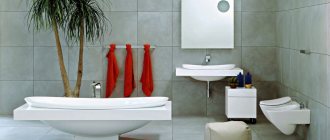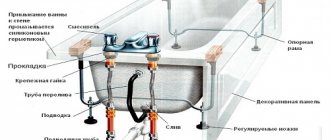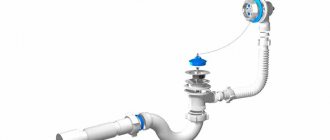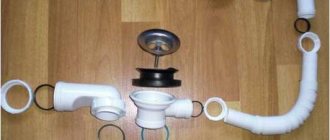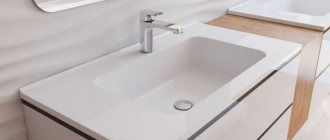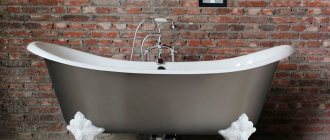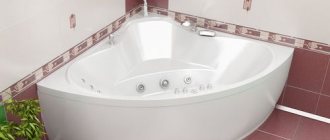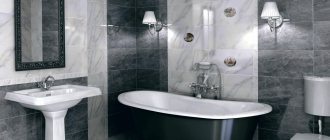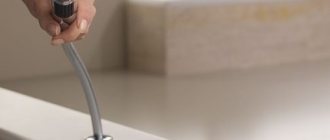Choosing the size of a bathtub for a bathroom is far from a trivial task, which can be handled either by a specialist who understands what to look for, or by a well-trained enthusiast.
We will tell you what sizes of cast iron bathtubs are considered standard, “running” and how to choose the optimal bathtub size depending on the size and shape of the bathroom.
Cast iron bathtubs have been sold on the Russian market for decades. With the advent of acrylic and steel bathtubs, cast iron tubs briefly lost their relevance. But the advantages of cast iron bathtubs (low thermal conductivity, stability and strength) did not allow them to become a thing of the distant past without a trace. And modern buyers increasingly prefer proven material.
A little criticism
In the sizes of corner baths, unlike conventional ones, the length of the rod is reduced by 200 mm.
It turns out that when purchasing a 1.7 m structure, in reality we get the same result - the advantages of an ordinary half-meter font. The standard 1.5 m model occupies 1.05 square meters.
m. area. The width of the corner analogue, when calculated, leads to almost the same figure = 1.45 m. In addition, after installation, the opposite corner remains unused, for the reason that practically nothing fits into a small niche.
What else do you need to know in order to do everything right?
1) Check with the manufacturer for completeness and make sure that the store does not double-count the items that are already included in the kit:
- supporting elements (stands or legs);
- electrical potential equalizer;
- drainage equipment;
- bath passport;
- instructions for installing and using the bathroom.
2) The bathtub is mounted on supports (stands, legs, etc.) and the distance from the floor to the bathtub drainage hole must be at least 14.5 cm .
3) After installation, it is necessary to measure the distance from the floor to the top edge of the bathtub in four corners. The difference between the largest and smallest value should not exceed 4 mm . A properly installed bath will be stable and able to withstand a load of 100 kg (applied to the longitudinal side of the bath between the supports anywhere vertically downwards).
4) The bathtub is connected to the sewer using a special floor-type siphon, which is a hydraulic valve.
5) The installation height of the bathtub is the distance between the floor level and the upper edge of the bathtub. For different rooms there are different rules for the height of installation of bathtubs:
- 600 mm . – in residential and public premises and production facilities;
- 500 mm . – in schools, kindergartens, children's medical institutions and in premises for people with disabilities.
NOTE: The bottom of the bathtub must have a slope ( 2 cm for each meter of bathtub length) to allow water to drain into the sewer. To check the slope, you must pour at least 10 liters . water. If the manufacturer has specified the correct geometry, there will be no water left after opening the drain hole.
We talk about cast iron structures
- The peculiarity of cast iron is to quickly heat and also quickly cool water. This requires maintaining a constant temperature regime during relaxation.
- The enamel of the bathtub is subject to mechanical stress, although it is protected by a special film. Particles easily fly off the shiny surface, revealing a black trace of the base. The restoration required a long process and the help of specialists. But trouble rarely happens.
- Dimensions and weight create difficulties during its installation (up to 130 kg).
The complex technology of iron casting is not provided for in different configurations. Cast iron is melted in a blast furnace at very high temperatures, then poured into molds, crystallized, polished, given its usual appearance with enamel, and hardened again. Companies have their own technological tricks, but the common thing is the use of vacuum forming, which affects excellent quality.
The quality of the enamel is responsible for
the duration of operation. A uniform white coating should be 0.8 mm, a colored coating should be 1.2 mm. Certain plumbing companies apply enamel manually (Jacob Delafon) in two layers. Silver ions are added to titanium salts, and with such impurities in the composition, the enamel is the most durable. We are accustomed to the monopoly of white in plumbing, so we are just learning to accept the rainbow collection from Marco Polo .
Overview of corner structures
The models can be installed in any corner you like.
Baths are produced:
- in the shape of a triangle;
- quarter circles - with smooth lines of corners;
- asymmetrical;
- trapezoidal.
Non-classical configurations are less durable. The corner bathtub is a non-standard design, which, thanks to its interesting shapes, is associated with an oyster shell or an open fan.
There are models:
- Left-handed.
- Right-handed.
- For two people.
- Jacuzzi - with hydro and air massage, chromotherapy.
If you treat the coating with care, the bath:
- will not corrode;
- will not lose shine;
- dimensions and graphite elements make the product resistant to vibrations and reduce the noise of flowing water;
- operation lasts for decades (up to 25 years);
- there is enough space at the bottom of the structure to equip it with hydromassage and filtration systems;
- The depth of the bowl is noticeably different from the standard model.
Properties
Manufacturers of corner cast iron bathtubs have occupied a rather profitable niche in the plumbing market. The high popularity of the angular shape and the time-tested durability of cast iron have become the most effective pair in the world of bathtub production.
Considering the great rarity of such designs, the demand for them is growing even more.
Advantages of a cast iron corner bath:
- durability;
- wear resistance;
- resistance to temperature changes;
- is an economically profitable purchase, since you will have to repair or replace it in at least ten years;
- attractiveness;
- the material perfectly retains the heat of water;
- easy to restore: most often, a cast iron surface needs to update the surface gloss;
- ease of use.
The cast iron corner bathtub will delight you for a long time due to its robust construction
This combination of the advantages of corner construction and durable cast iron is the most practical choice for your bathroom. It is the quality characteristics that determine the high popularity of the product.
Disadvantages of a corner cast iron bath:
- the most vulnerable part of a cast iron bathtub is the enamel; it is the one that is most often susceptible to chipping, cracking and abrasion;
- the heavy weight of the structure makes it difficult to transport, deliver to the apartment and install itself;
- the angular shape, like the weight of the bathtub, further complicates the installation process;
- uneven enamel is a sign of poor quality construction;
- high price.
The main disadvantage is the heaviness, however, it is difficult to refuse such a reliable product because of its weight, because it is this that determines the reliability, stability and strength of the bathtub for decades.
Cast iron corner bathtub has a high cost
Today's production offers us various options in design, shape, color, however, acrylic analogues will cost much less, but they also have a shorter service life.
Who should you buy from?
Domestic products dominate sales. It differs from imported analogues in the thickness of the walls: their bowls are made of 5 mm cast iron, but the slight difference in favor of Russian models does not affect the high European quality. They look more elegant and are equipped with comfortable handles, a screw device for height adjustment, beautiful fittings and little things that provide pleasant relaxation.
Models from Kohler (USA) are especially interesting. The company has a rich history in the production of plumbing fixtures, and judging by some products costing 150,000 rubles , perhaps there is no need to doubt the design and quality. Competing with the American manufacturer are Jacob Delafon (France), Odoksan (Turkey), Goldm (China). The brand and material determine the cost. Thus, ROKA is sold for 12,000–18,000 rubles. Economy class models range from 7,000 to 8,000 rubles.
The price of Russian models from the Kirov plant starts from 5,000 rubles, from Novokuznetsk - from 7,000 rubles. Chrome elements and related accessories for equipment add to the price from 700 to 1800 rubles.
Quality of casting material
When purchasing a bathtub, it is important to inspect its surface for scratches, different shades of the surface, chips, dents and other various defects. The surface of the bowl must be smooth, even and provided with a protective composition. These are the models presented in the AlloVanna online store. The enamel is distributed smoothly throughout the bowl, depressions and roughness are not detected, which means that the service life declared by the manufacturer will be correct.
To clarify any details, you can call or leave a request for a call back. Compared to their predecessors, the proposed cast iron bathtubs are elegant, lighter, and distinguished by high quality and long service life.
Comparison with acrylic bathtubs
I would like to draw parallels with acrylic bathtubs, identical in shape and different in content. They are the ones who focus the main attention of consumers. Perhaps the beautiful “packaging” and the efforts of technology have indeed surpassed the quality of eternal cast iron.
Minuses:
- Reinforcement with fiberglass threads and installation on metal frames cannot cope with the flexibility of plastic.
- The bathtub is attached to the corners of the wall or hung on hooks.
- The design involves a concrete podium during installation.
- Lots of fakes. The basis is porous plastic, which is quite fragile and can crack even at the installation stage.
- In the case of a rectangular model, you can use sliding panels of a decorative bathroom screen to store small items. In the corner version, it is tightly attached.
Pros:
- You can’t argue with the beauty of the shapes and the variety of colors of the bowls. They are harmonious with any design and will always support the aesthetics of the bathroom. There are combinations of acrylic and glass that have become quickly popular.
- The fact of combination with a shower stall is also important. You can purchase them as a kit or equip the system yourself. The option is not cheap, and if you choose the second version, it will cost even more. By the way, standard forms can also be supplemented with a cabin, but this approach will not be in favor of comfort.
A little more about the jacuzzi. This is the same corner-type plumbing system, suitable for installation in any bathroom. If you equip any model with the appropriate technical attributes for massage, you will get a complete match with the original. Water supplied under pressure, passing through small holes, will provide a pleasant service, breaking into drops on the body. Roy Yacuzzi's invention will be appropriate in every home.
Cult of pure body and pure spirit
In Rus' the cult of the clean body has always been revered. In addition to public baths for city residents, in villages a log bathhouse was built . Traditional rules of bathing procedures can be considered as a separate culture. It represents an organic combination of unitary tasks with a certain ritual and intimate conversations. The well-known men's trips to the bathhouse strengthened male friendship. Steam room, brooms, resinous steam, linden tea are indispensable attributes of a Russian bath.
Cast iron bathtubs appeared in Russia under Peter I. At first, the bathroom was only in palaces and rich mansions. With the development of cities, cast iron baths appeared in city apartments. A cast iron bathtub was installed in every Khrushchev house. Even in conditions of poor living and cramped conditions, weekly bath days are an unshakable rule of Russian life.
Installing a corner bath
- If the old structure is dismantled, the site should be prepared. First, we remove the nearby plumbing fixtures—the corner sink. If the riser is functional, that’s one less problem.
- We unscrew the siphon from the sewer and put it away to avoid the smell. Naturally, we also plug the sewer pipe.
- Now you should take out the old bowl. If it was mounted on legs fixed with cement, you will have to swing a sledgehammer.
- We focus on the walls. The slope of the bathtub implies a flat surface, and if smoothness is required from the walls, leveling should not be neglected.
- The bathtub can be placed on legs or a low concrete foundation. The second option will require mixing mortar and brickwork.
- After the cement has dried, we attach the outlet to the siphon.
- We place the structure on the podium and finally fix the parts to the sewer.
- At the last stage, we apply sealant along the seams and gaps.
- We collect water and check the connections.
Cast iron is stronger and more reliable than other materials. Of course, there will be difficulties with delivery and installation due to the weight of the structure. But with one effort, you will solve the plumbing issue for a long time. This is the choice of conservatives who value traditions and guarantees. If you want to make the design unique, select an acrylic product to match the color of the walls, and further use will show how lucky you are.
